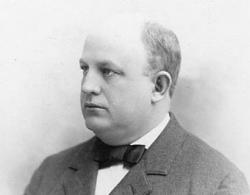William Jefferson Hunsaker facts for kids
Quick facts for kids
William Jefferson Hunsaker
|
|
|---|---|
 |
|
| 4th Mayor of San Diego | |
| In office January 3, 1888 – November 13, 1888 |
|
| Preceded by | George P. Tebbetts |
| Succeeded by | Martin D. Hamilton (acting) |
| Personal details | |
| Born | 21 September 1855 Contra Costa County, California |
| Died | 13 January 1933 (aged 77) Los Angeles, California |
| Political party | Workingman (until 1896), then Republican |
| Spouse | Florence Virginia McFarland |
| Children | 5 |
William Jefferson "Will" Hunsaker (1855–1933) was an important American lawyer and politician. He lived in San Diego and later Los Angeles, California. Hunsaker held several key roles during his life. He served as the San Diego County District Attorney and was the 4th Mayor of San Diego. He also became the president of the California Bar Association.
Contents
Early Life and First Jobs
William Hunsaker was born on September 21, 1855, in Contra Costa County, California. His parents were Nicholas and Lois E. (Hastings) Hunsaker. His father, Nicholas, moved to California in 1847. He served as the sheriff of Contra Costa County for several terms.
William's mother, Lois, had an uncle named Lansford Hastings. He wrote a famous guide for people moving to Oregon and California. Nicholas Hunsaker moved his family to San Diego in 1869. There, he also served as the sheriff of San Diego County.
When William was 16, he started learning the printing business. He began as a "printer's devil," which was a beginner's job in a printing shop. He then worked as a skilled printer for two and a half years. After that, Hunsaker decided to study law. He trained with lawyers Major Levi Chase and Albert C. Baker. He became a lawyer in 1876.
On February 27, 1879, Hunsaker married Florence McFarland in San Diego. They moved to Tombstone, Arizona. In 1881, Hunsaker helped his law partner, Thomas Fitch. They worked together to defend Wyatt Earp in a famous legal case. Years later, when Earp passed away in 1929, Hunsaker was one of the people who helped carry his coffin.
Becoming a Public Official
Hunsaker's first elected job was San Diego District Attorney. He served in this role from 1882 to 1884. When he ran for the position, he campaigned actively. He traveled across most of San Diego County. At that time, the county was much larger than it is today. It included areas that are now Imperial County and parts of Riverside County.
In 1887, Hunsaker ran for mayor of San Diego. The city had not had a mayor for 35 years. During that time, a group of trustees managed the city because it had faced financial problems. Hunsaker ran as a candidate for the Workingman's Party. This party supported the interests of working people. They wanted workers to have a bigger share of wealth. They also promoted businesses hiring local workers.
Hunsaker won the election for mayor. He defeated his opponent, D. C. Reed, by 1041 votes to 867. He officially became mayor on January 3, 1888.
Even though Hunsaker won, the city council was mostly made up of members from a different party. Hunsaker felt he was not able to work well with the council. He resigned from his position on November 13, 1888. After leaving office, Hunsaker went back to working as a lawyer.
Later Career and Achievements
In 1889, William Hunsaker worked on a well-known case. He defended someone accused in the death of the Oceanside marshal. In June 1892, the Hunsaker family moved to Los Angeles.
From 1893 to 1896, Hunsaker was a lawyer for the Atchison, Topeka and Santa Fe Railway. He also kept his own private law practice. He defended E. S. Babcock in a case related to a water company. After leaving the railway company, Hunsaker continued his private law work. He later partnered again with Eugene W. Britt, who had been his partner in San Diego.
Hunsaker changed his political party in 1896. He had been part of the Democratic Party but disagreed with some of their ideas. He then joined the Republican Party. He supported the campaign of William McKinley. However, Hunsaker often acted independently in politics. From 1896 to 1906, he led a group called the Committee of One Hundred. This group of important citizens published non-political voting guides for local elections.
In 1901, Hunsaker was elected as a "junior vice-president" of the Los Angeles County Bar Association. He also became a delegate for the 1901 American Bar Association convention. In 1904, Hunsaker attended the American Bar Association meeting. He was there as a vice-president and delegate for the California State Bar Association. He was also elected as a vice president of the ABA. Later in 1904, Hunsaker became president of the Los Angeles Bar Association.
During this time, Hunsaker defended major California newspapers. He helped them in several important legal cases. In 1908, Hunsaker was president of the committee that revised the Los Angeles City Charter. He was also a leading candidate for a position on the California Supreme Court. In 1911, Hunsaker was elected vice president of the California Bar Association. Then, from 1913 to 1914, he served as the Association's president. Hunsaker was also a lifelong member of the Native Sons of the Golden West.
Family Life
William and Florence Hunsaker had five children. Their names were Mary Cameron, twins Florence King and Lois, Rose Margaret, and Daniel McFarland. Sadly, Lois Hunsaker passed away when she was only nine months old in November 1882.
Florence passed away on November 24, 1928, before her husband, Will. Will Hunsaker died at his home in Los Angeles on January 13, 1933. He is buried in the Hollywood Forever Cemetery in Los Angeles County.
Images for kids


